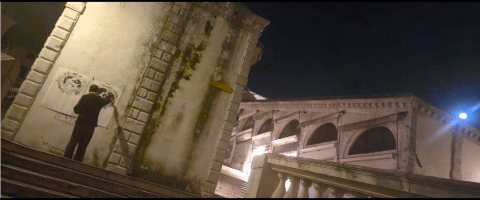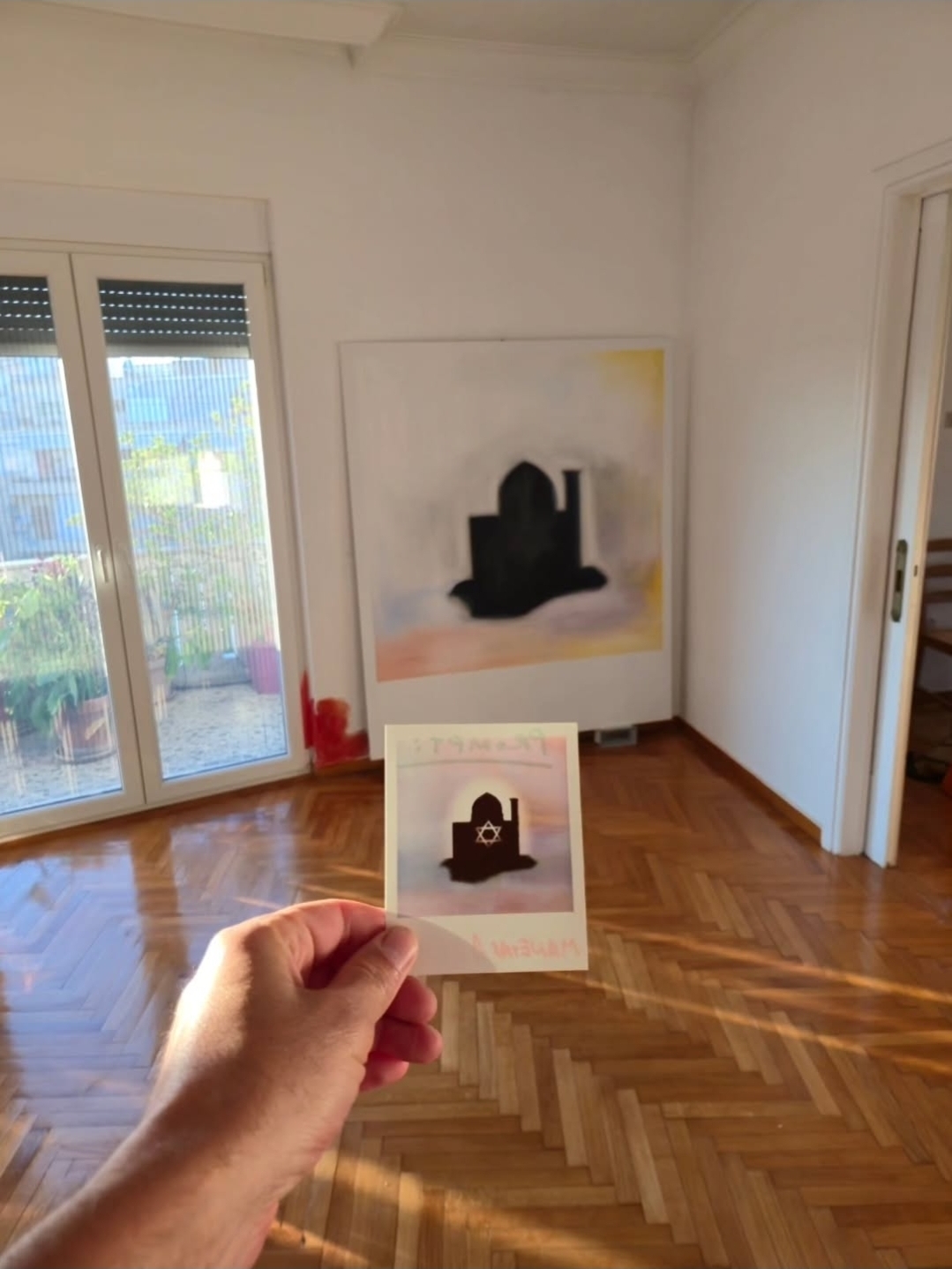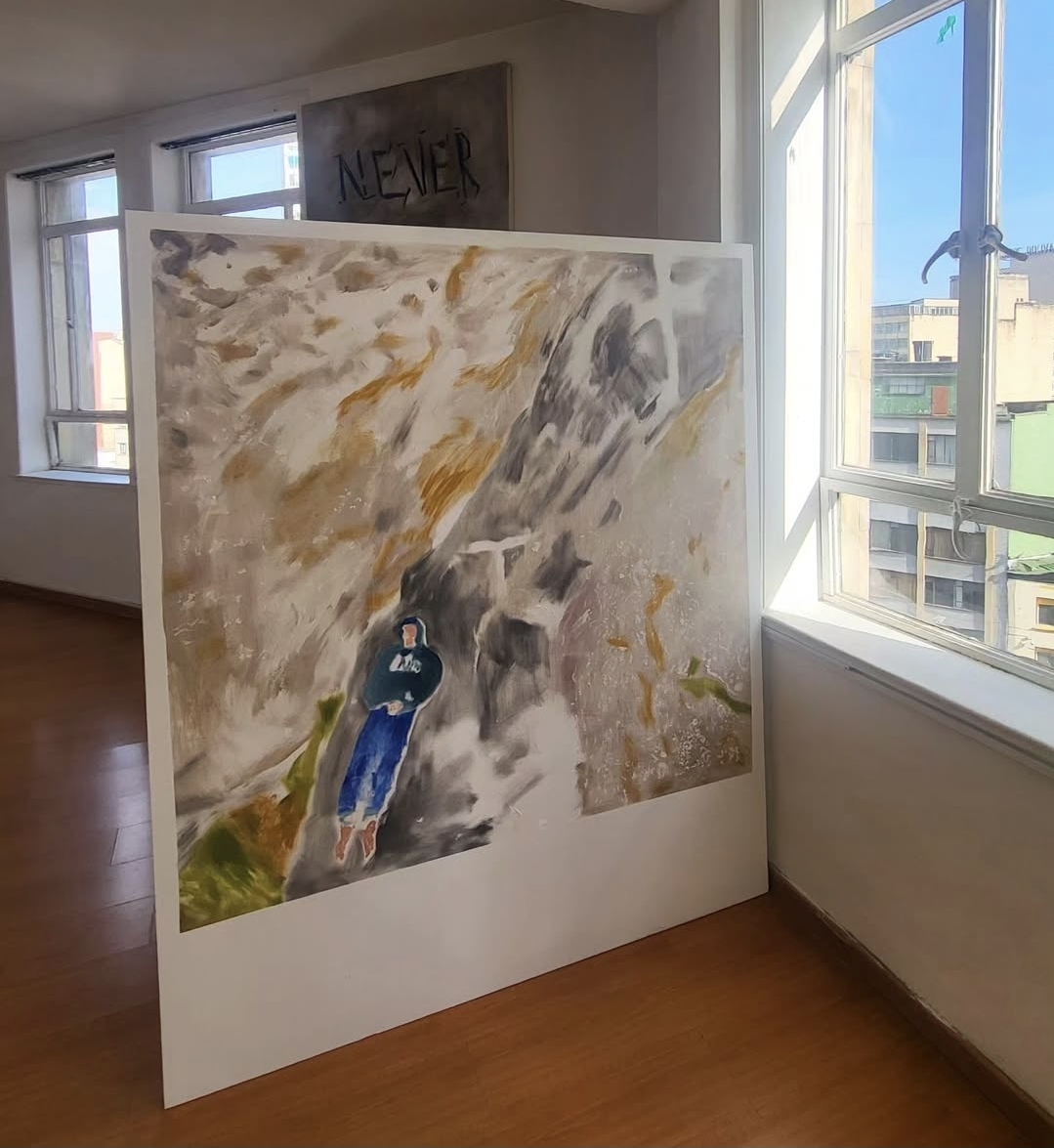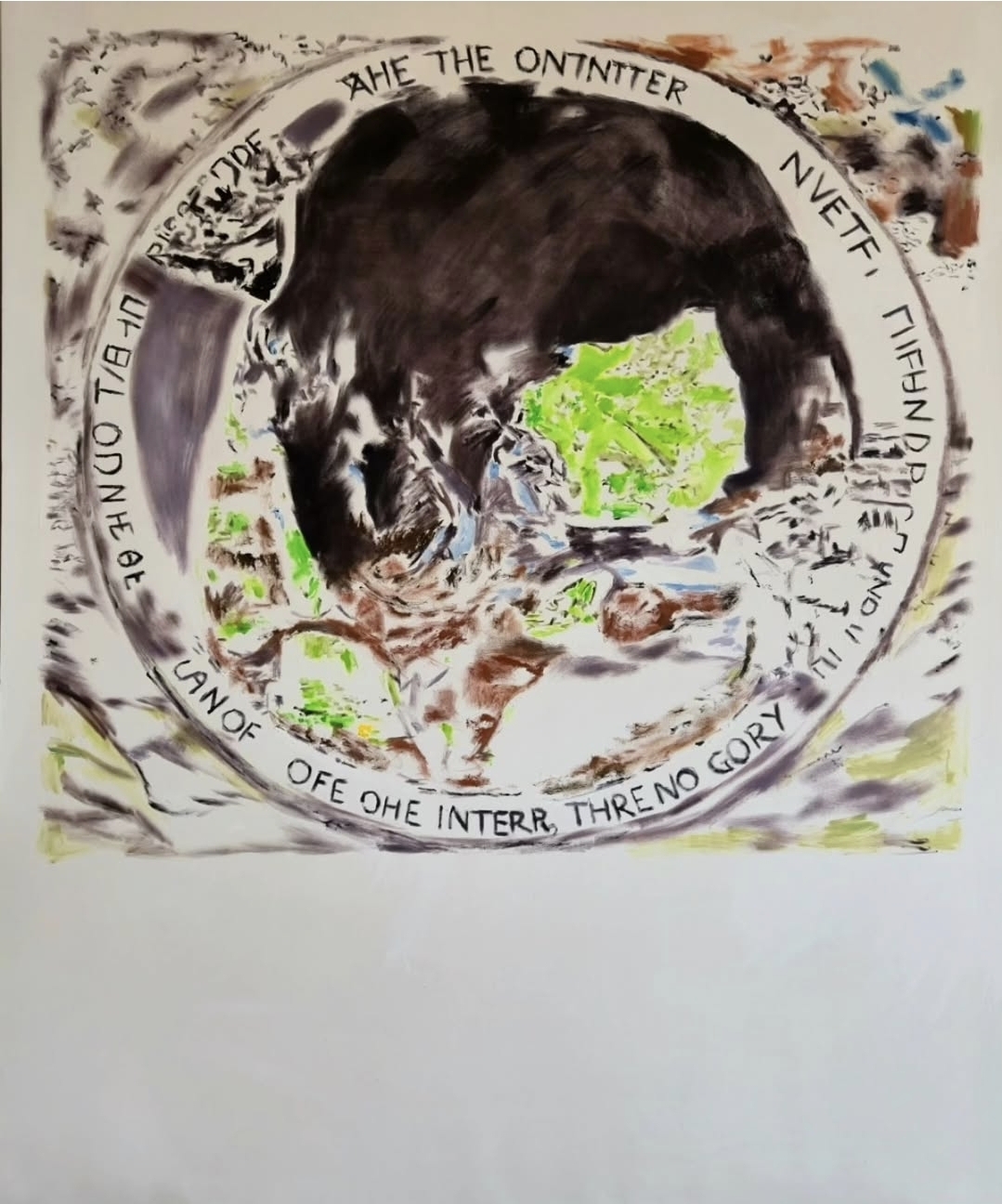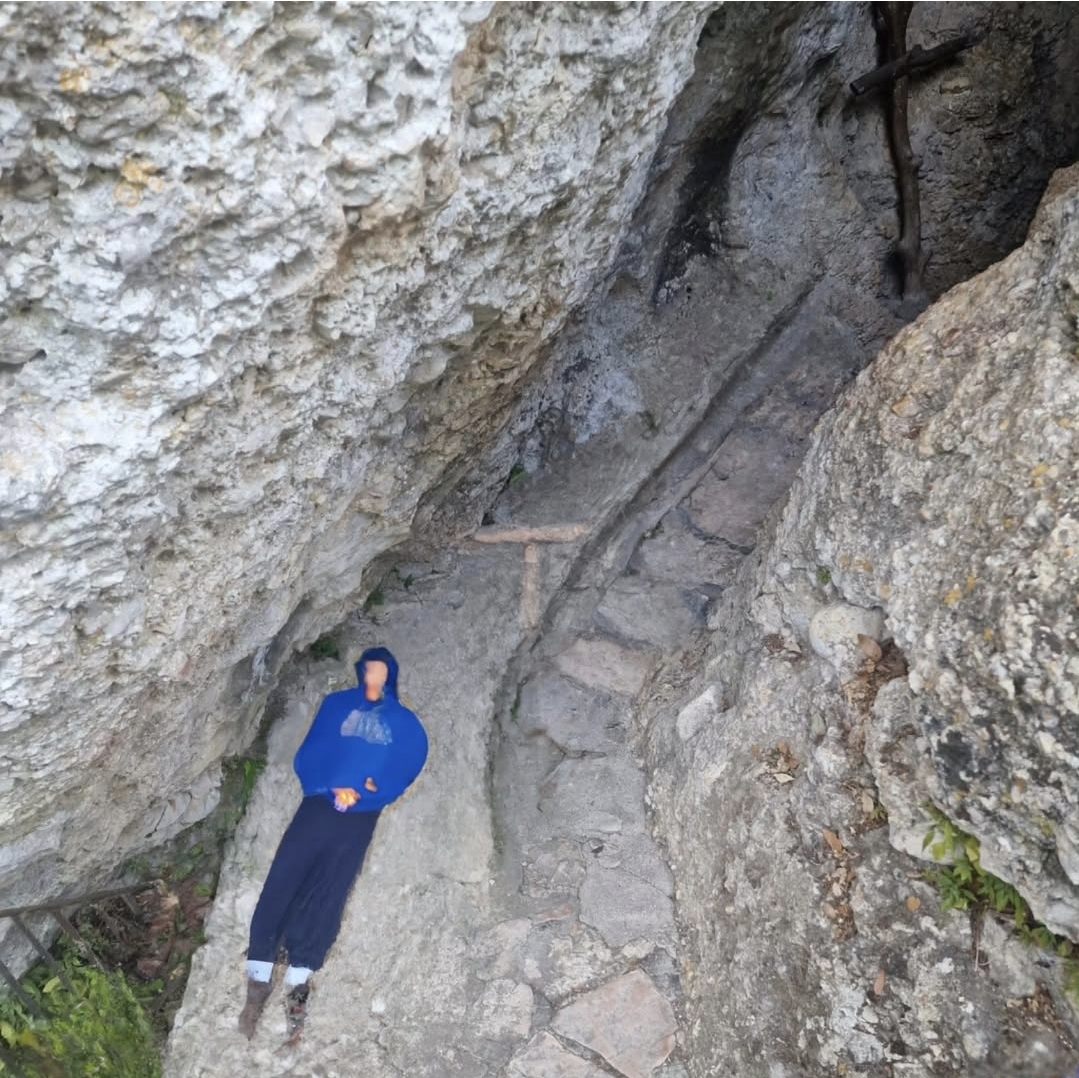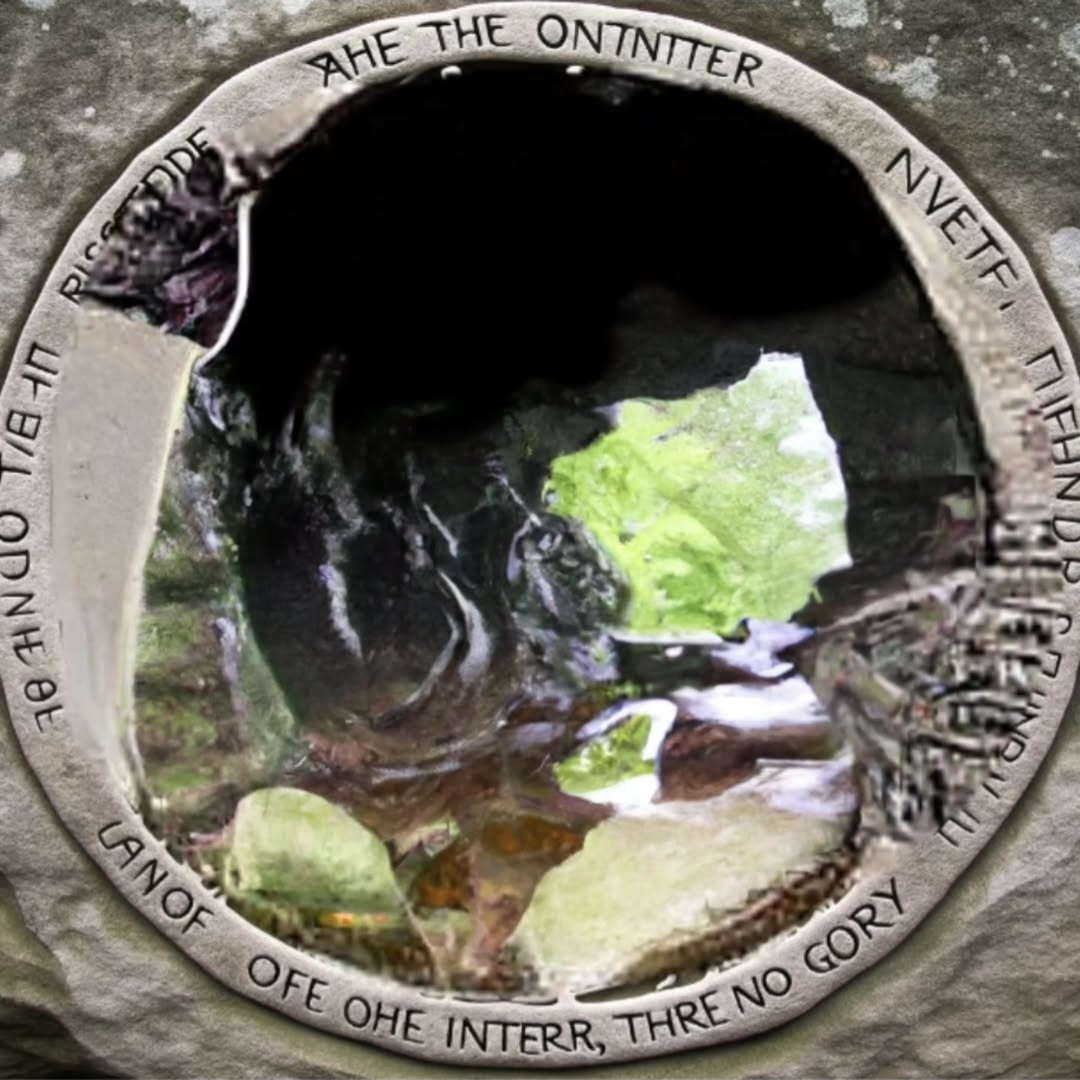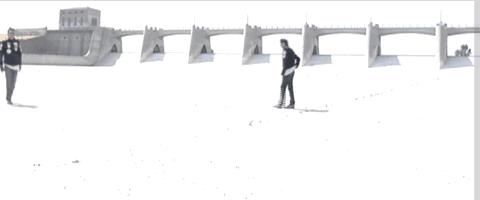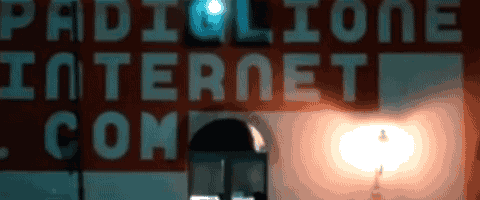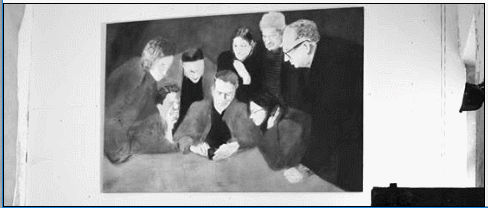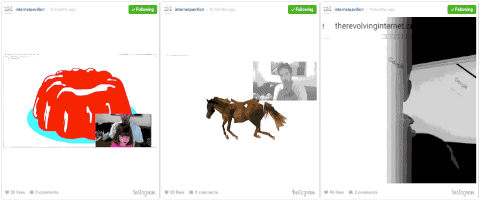INTERNET

PAVILION OF THE

VENICE BIENNALE

INSTAGRAM: @internetpavilion
COMING IN MAY 2026, “INSTAGRAM”
Instagram is the AI that matters
The true AI today is… Instagram . It’s not an AI for the lazy; to set up the prompt, you first need to prepare the platform: your Instagram account must be ready for the necessary calculations, and, moreover, the computation must be quantum, not digital. Suggestions should appear that are valid in very different parallel universes. Your feed should generate evidence of contradictory realities and, at the same time, everything should somehow always be sincere. Your IG must be absolutely personal, so personal that it attracts relatively few followers (according to my calculation, which could be wrong, around 11,111 "perfect followers"). Additionally, your profile must be the tip of a pyramid of other profiles that are absolutely specific but also completely experimental. The full spectrum of your daily experience—and, if possible, all your past memories and future fantasies—must be part of this pyramid of Instagram accounts. There must be the personal—Instagram accounts where you observe your relationships with the people in your world; there must also be the social—Instagram accounts where you document your perspective on the major wars occurring during your lifetime. Continues in Venice at the 10th Internet Pavilion in May 2026.
THE INTERNET PAVILION FOR THE VENICE BIENNALE
This new Pavilion marks the convergence of two fields: Art , where the Pavilion was born in 2009, and Architecture , where it transformed in 2024 under Despoina Damaskou.
In 2026, these two lines cross again — a Pavilion both built and unbuilt, material and networked, expanding from Bogotá, Athens, Todi, and Venice, and returning to the Internet as its natural territory.
“BOGOTÁ EFFECT”
BY DESPOINA DAMASKOU
"Because it's being Drawn and Redrawn"
"Ecclesia del Prompt" In Bogotá
"Diabolo/The desk where I did my Homework"
I AM PAINTING AI POLAROIDS FOR SPAGHETTO TOPOGRAPHY
Because AI is today's MODERNITY
OIL
ON
CANVAS
AFTER
DALL-E 2
PROMPTS
BIENNALE DI VENEZIA 2024
8TH INTERNET PAVILION, "CHURCH OF PROMPTS"
"Church of Prompts" The 8th INTERNET PAVILION for the 60th Venice Biennale presents "Church of Prompts" by Miltos Manetas and Despoina Damaskou, happening in Bogota Colombia at Damaskou's SPAGHETTO SILO BOGOTA during the 60th Biennale di Venezia.
Venice In Bogota
Torres del Parque
La Biennale di Venezia
FIRST INTERNET PAVILION
"The Embassy of Piracy"
For the first edition of the Internet Pavilion, Manetas and Aman invited to Venice a number of people involved with the activist website ThePirateBay.org to inaugurate the „Embassy of Piracy“. Just a few hours after the press-statement of Padiglione Internet was released, the administration of the Venice Biennial began receiving calls from the Berlusconi Government ordering from them to cancel the invitation of ThePirateBay.
Jan Åman
Jan&Daniel
J&D&Miltos
Pirates
For the first edition of the Internet Pavilion, Manetas and Aman, decide to invite a number of people involved with the activist website ThePirateBay.org to come in Venice and inaugurate the Embassy of Piracy. But just a few hours after the press statement of PadiglioneInternet was released, the administration of the Venice Biennial start receiving calls from the Berlusconi government asking them to cancel the invitation of ThePirateBay.
"We are Pirates of the Internet
Pirates of the World Wide Web
Nothing that can stop us now
We are here to stay..."
The Pirate Bay
I start driving...
All around US
"I start driving all over America searching for something different from what I knew already about the Internet.
Before starting this trip, I spent a sleepless week in Paris during Paris Fashion Week. That years's fashion shows were not interesting, maybe because of the recension or for other reasons, there wasn't anything really memorable out there. At some point, I found myself alone at Le Montana's bathroom, trying to think between lines of exquisite cocaine and semi-naked bodies. Still thinking that I should make some kind of real-space pavilion, I felt the urgency to find an architect who would eventually design it.. Later that night, back at Le Marais, at the apartment of my very smart friend Benjamin Loyaute I wake up Benjamin and asked him if he had any ideas. What about Tadao Ando" Ben said, "I can't really think any architect other than Ando at this hour. I can put you in touch with him through a friend of mine knows him well"
Fashion Week
Dear Mr. Ando...
Jean Nouvel&Mia
C.Wassmann
Liter turns to meter
Excess Material
Accepted..
The day after, I wrote to Mr. Ando.
"Dear Mr. Ando.
What's "Internet" in terms of space?
How do we walk in the Internet, how do we even circulate without dying from boredom? We need you to design the first Internet Pavilion. Not complicate Net-architecture, no "Avatars", "Virtual Worlds", or "Second Life" and the such: all this is exactly what we want to avoid. We need something poetic and influential instead, something suggestive, as suggestive as the engravings of Claude-Nicolas Ledoux.
But Tadao Ando wrote back that he had no time to make the Pavilion. At that point, Jan Aman thought of Mia Hagg and of her boyfriend of those days Jean Nouvel.
I called Mia and we agreed to meet them at Le Fondation Cartier where Nouvel was invited to a dialogue with theorist Paul Virilio. The two were conversing in French and I couldn't understand anything apart of a few words. So I sit back on my armchair and I start writing subtitles in my mind, fantasizing about what Nouvel and Virilio were talking about. I had never read any of Virilio's books, but at some point, - "L'écran du Désert"...
The Vatican...
Mr. Kleinrock
from any place...
Pirate Bay on trial
Aerial Tramway
3 complains
Our intention is to re-define and to we-write everything: all terms should be renewed, all systems should be destroyed and build again.
The internet is cool but its also a nightmare, an empire of psychologically enforced work, really a "desert of computer screens". We have a strong desire for a brand new Internet and at the same time, our desire is also to free ourselves from machines. We want to be able now to send emails without computers. We also want to satisfy the Three Kleinrock Complains:
1. We should be able to connect by any place
2. We should be able to connect by any device
3. The device should be invisible, even immaterial.
Internets today is not some virtual entity but a network that can materialize in everything, from court systems, parliaments and phone networks, to memes, music and art systems. Forget browsers, files and computers, internet is everywhere. It is wherever you are ready to receive it. (Embassy of Piracy, 2009)
"Internets" are those real places or contexts, where it is possible to revert everything just by using the power and the possibilities that a computer and a network connection is offering today to everyone.
(Miltos Manetas, everymanwithacomputerisanartist.com, 2000)
read full story
"The Internets"
"Internets" is a word first used by the former United States President George W. Bush during the 2000 election campaign. "We can have filters on Internets where public money is spent. There ought to be filters in public libraries and filters in public schools so if kids get on the Internet, there is not going to be pornography or violence coming in".
(George W. Bush, presidential debate against Al Gore on October 17, 2000.)
and on the evening of October 9, 2004, the day following the Bush/Kerry debate:
"I hear there's rumors on the Internets that we're going to have a draft. I don't know how many of these Internets are carrying these rumors, but they're just wrong. I think the problem here may be more of a question of getting rid of the bad Internets and keeping the good Internets. You know, 'cause I think we can all agree … there're just too many Internets."
(George W. Bush)
read full story
George Bush : )
In San Francisco
After meeting Leonard Kleinrock at his office in the UCLA, I got again into my car and headed towards San Francisco. Two weeks passed by in a very frenetic rhythm, I remember visiting absurd places at the Silicon Valley where very people live -US misery in all its glory- next to the likes of Microsoft and Apple. Going back to LA to meet Durek Verrett, a contemporary Shaman, I stopped for a night at the Big Sur. I had no idea that Henry Miller used to like it there, neither that there was such a thing as the Henry Miller Memorial Library. Still, that's where I found myself buying a copy of Homer's "Odyssey". I took that book with me in LA and I show it to Durek while he was trying to explain how- according to him- "computer screens are hypnotizing us".
As I was leaving Durek's house in a taxi, going directly to the LA's airport (and from there to my studio in London), I felt my ideas about the Internet Pavilion clearing up.
What was wrong with today's internet and with today's computers altogether, was the fact that everything was based on screens. "Screen" comes from the Middle Dutch "scherm" that means "cover" or from the Frankish "skrank" which means "barrier". As a verb, it means "to shield, to conceal". Screen is a barrier that "covers in order of protecting" but while it does that, it hypnotizes us. There is definitely a great beauty on anything with a hypnotic power, infact, most of the art I like calling Neen, has that power. But what about a network that doesn't depend on screens, a network where nobody is "hypnotized"? What if we"ll start thinking of "Another Internet", start thinking of some kind of SlowNet?
Ready for it
Courbet
The Artist’s Studio
In 1855, the French artist Gustave Courbet submitted his now famous painting "The Artist’s Studio" to the World Exhibition in Paris. Although nobody realised it at the time, Courbet, the prophet of Realism, was making history by calling his painting a real allegory. Instead of the old symbolic figures, he was painting people from real life-not just those writers, thinkers and poets that had influenced him (Proudhon, Baudelaire, Champfleury), but also priests, prostitutes and workers. All of those people portrayed were based on real, living characters, but also carefully chosen to tell a story - Courbet wanted his painting to display his thoughts about society at that time what were the consequences of this new industrial society? And what could art’s role be in it? The painting was refused. But, using his own money, Courbet rented a venue just next to the world fair, and displayed the painting anyway.
Fast-forward to 2009 and our Courbet inspired Padiglione Internet (Internet Pavilion). It digs into a series of contemporaneous issues - threats of political restriction, the future of the internet, copyright, the art world itself; of borders,markets, curators, collectors, city marketing, and artists... the list goes on. It does so because of the fact that it is a virtual art pavilion, and as such the first of its kind at the Venice Biennale. All of this was clear to me when Miltos Manetas, came up with the idea, and it has become more and more evident as the journey has unfolded...
Jan Aman, PADIGLIONE INTERNET: Some Simple Starting Points
In Sinai
Where is Miltos?
The Padiglione Internet has its roots in a tiny, confined art world - but it made a connection to the big world. We invited in a virus, something uncontrollable - that energy around the Pirate Bay - just to see what would happen. We did invite others but it was really only the pirates that responded. They wanted to go to Venice. Nobody else cared. Or were too scared. To me, the "Embassy of Piracy" is not primarily about copyright issues. It is about the possibilities of a new world. But it is produced by people that understand marketing - and the issue of copyright is one that gets the attention. In the context of the Biennale, the "Embassy of Piracy" was all about letting in a new reality - one that tells a different story about the future to an art world that is still stuck in 1855.
(Jan Aman, PADIGLIONE INTERNET: Some Simple Starting Points)
Only a week remained before Venice Biennale's opening. And with it the Internet Pavilion, for which Miltos Manetas and myself were jointly responsible.
I had just arrived in Venice. I had had time to meet Chiara, our local hostess and her friends. I had visited S.A.L.E., where Marco had offered us his beautiful old salt warehouse. I had been out with Nik, Helga and Daniel from AIDS-3D. I’d been out drinking wine with Jan Håfström and Lotta Melin.
But I hadn’t really done anything. I spent my days mostly wandering around by myself. Which admittedly is one of the things Venice is best for. But the reason I was there – Miltos – was nowhere to be found. He didn’t answer my calls. He didn’t respond to emails. It wasn’t like him....
ZOOM TO SINAI

Back in the UK
I arrived in the UK on May 20th 2009. Only ten days were left for the opening of the Biennial, I should be doing some last duties in London and depart for Venice. But for some reason, I wouldn't buy my ticket, something inside me was telling me that I should be going somewhere else instead. But where?
As the Internet Pavilion was officially part of the Venice Biennial, the Italian Vogue had arranged an interview and photo-shoot at my studio in HighGate to be included in its traditional Biennial Issue of Uomo Vogue. The interview was conduced by Angela Maria Piga and as I was replying her questions, I had a revelation.
Angela Maria Piga: Paul Vilirio has defined as Dromology the logic of Speed. Such Speed has alternate our perception of time as well as space: in some way, a monk of the Dark Ages, who would wander around the globe in conditions we can't even start imagining, was more conscious of geography and history that what we are today. As for communication, Internet was supposed to bring us closer...
Then to Sinai
Miltos really had climbed Mount Sinai. He had walked up the mountain. He had climbed it despite his fragile legs (he has a disease which makes his skeleton very brittle). Just as Moses had once climbed Mount Sinai to meet God and from his hand receive the stone tablets with the ten commandments, Miltos had now climbed it too. While Moses climbed, the people of Israel waited in their tents at the foot of the mountain. When Miltos made his way up the mountain, the ground below had been quiet and empty of people. His people were perhaps in Venice.
As Miltos described his journey, things got increasingly lively around us. It was as if the Venice Biennale actually got started as we sat there. People literally dropped in on us at the café: artists, journalists, curators. People we knew or who recognised us. They sat down and began to talk to us about what we were doing or about their own doings during the Biennale. They bought us wine. The conversations continued – conversations that became increasingly intense and increasingly devoid of meaning. Conversations that turned into dinners and parties. And soon enough openings and press conferences. Since the pirates were there, interest focused on them. Which was precisely our calculation. Everything went according to plan.
From "On Miltos, Moses and Marcel" by Jan Aman
Moses...
Arriving at Sinai it was already late. I asked the taxi driver where I could spend the night and he suggested "The Desert Fox Camp", located at a short walk's distance away from the Monastery of St. Catherine and right at the foot of the Mt. Sinai massif. Managed by Faraj "Fox" Mahmoud, the camp was a magic place and even more, for some reason, I happened to be their only guest!
"We are going to the desert to play some music" Faraj "Fox" Mahmoud, had told me as he was offering me some tea.
"Do you want to join us?"
Looking at him and his friends I could see they were all Beduin men. But there was also a female between them, a British girl, the wife of Faraj. "Beduin women aren't allowed to going around with men, they spend most of the day at home doing jobs. Because of the internet though, these women are today very well connected and they are actually controlling and managing everything from a distance." she told me .
I decide to join them and a while later, I found myself at a very lonely place in the middle of the desert. I watched the bedouins preparing the necessary for their improvised rave-party. They had with them their traditional shabbabas, a length of metal pipe fashioned into a sort of flute, and their rababas, a versatile, one-string violin. Soon all of these instruments were lying on the desert's floor as the men were installing a few huge speakers on the top of their Hyundai cars. Before start playing though, they produced their smartphones- they all had very contemporary smartphones supplied with strong internet connection.
"Network is not a problem, we have very good connection here in the desert" they told me, "A strong connection is necessary to share this moment with our people at home".
They start playing and singing and at the same time, they would Skype with their relatives and friends in Nuweiba. Their friends and relatives from the village, were Skyping back to us sounds and songs which my new friends would amplify through microphones they had brought with them for that purpose and send them to the speakers they had installed on the top of their cars. A long-distance connected improvisation was taking part in the desert, music arriving from everywhere, a mystical "Other Network" was established! Filled with amazement, I was paying no attention to the food that they offered to me and I consumed a large quantity of their bread. As I happened to be in a strict no-gluten diet for my Crohn's disease, I wake up the next day with a very strong fever.

"Can you please bring me to San Catherine?" I asked the Beduins. I knew that at this old Greek Orthodox monastery, build sometime around 548, there was a guesthouse and I figured that it would be a better place to recover than "Desert Fox Camp's" cold rooms made by concrete . I spent the next two days there, shivering and vomiting, with my only company a book I found there. It was a book about Moses and about his quest of pulling his Jew out of Egypt...
Post-Internet
Oliver Laric
AIDS 3D
Petra Cortright
Martijn Hendriks
Pascual Sisto
Parker Ito
Harm den Dorpel
Elna Frederick
Guthrie Lonergan
performing Jesusswimming
A. Domanovic
digital to be copied
And the question remains, what was Miltos Manetas doing on Mount Sinai?
The image of God’s hands reaching down through the clouds to the lone Moses on top of Mount Sinai is etched in the minds of most of us since childhood. Few symbols – even in the symbol-laden Bible – are as powerful. Moses was given a slice of eternity. God’s words were hardly meant as a temporary solution. And when Moses descended from the mountain and showed the stone tablets to the people there were no suggestions for alterations. The commandments were carved in stone.
That puts things in perspective....
From "On Miltos, Moses and Marcel" by Jan Aman
top of the mountain
I never made it to the top of the mountain.. I was too tired, too exhausted from the fever, too worn out from my quest for an Other Internet Pavilion. I just made it half-way up, in the company of a beduin teenager who actually teached me one or two things to me (but that's a whole other story, the beginning of "Metascreen" that I start realizing only a year later).
I never met a God and never brought to the Venice Biennial the peculiar internet that Dr. Kleinrock was dreaming when he was a teenager himself.
I had fled from Egypt to Italy with empty hands, went straight to Fondamenta delle Zattere, straight to the Magazzini del Sale. The Pirates from the PirateBay.org were all there and sure enough, they had put on the "Embassy of Piracy" already!
Every morning, the anarchists of "Magazzini", would share their boats with them and they would go around all of them armed with Pirate flags, singing the beautiful "Pirates of the Internet" song, fighting copyright and intellectual property in front of a completely uninterested art crowd.
The artists that I had invited, were there too, they had installed their beamers and they were projecting their websites in a- somewhat pathetic but sweet- improvised installation that I believe inspired Rafael Rozendaal's BYOB (Bring Your Own Beamer) future operations.
Nothing of all that looked particularly good- it wasn't the Internet Pavilion I was dreaming. But I was too weak to argue with the artists and to try to convince them to turn off their projectors and trust the internet instead...
In the middle of Magazzini stood the skeleton of "PAGES", the Internet Space-turned-into-Place that Christian Wassmann had promised. It didn't looked good, somewhere in the conversion, Wassmann's beautiful idea had lost its proportion and its magic and had become just another furniture.
It wasn't Christian's fault though, it was simply the way things are in a world dominated by gravity..
I don't think that Le Corbusier's Phillips Pavilion looked that great in real either. What's important, is keep searching for what Wassmann calls "Excess Material", stuff that nobody is trying to create, nobody thinks is necessary, still it exists!
At my very last day in Venice, after a photo-shoot at Magazzini for While Dazed & Confussed, while Dazed's photographer Matthew Stone was packing away his cameras, I watched as Rafael Rozendaal was jumping to the dirty waters of the Giudecca. For a second, I saw him suspended over the edge of the water, a temporary human sculpture, the final artwork that was produced by the First Internet Pavilion. Matthew Stone-the photographer- also turned to look and as he turned, fired the trigger of his camera: a snapshot of the moment was frozen onto the wall of Digital-a reminder that gravity can be avoided.
From "On Miltos, Moses and Marcel" by Jan Aman
Internets
Mai & Tobias
Pirates & activists
Nikola Tosic
M/M (Paris)
DAZED&
CONFUSED
INTERNETS
Miltos&Moses&Marcel
Miltos Manetas is sometimes regarded as a painter. But he’s no ordinary painter. He’s a painter in the same way that Andy Warhol was, beginning by distancing himself from painting as a form of expression.
From "On Miltos, Moses and Marcel" by Jan Aman
(Partly written in Swedish and translated by Tomas Tranaeus, partly written in English and overviewed by Tomas Tranaeus.)
BIENNALE DI VENEZIA 2011
53th BIENNALE DI VENEZIA
SECOND internet pavilion, "The ISLAND OF THE NET"
"BYOB-ISLAND OF THE NET"
The Island of Internet & BYOB (Bring Your Own Beamer, an exhibition series created by Rafael Rozendaal) The artists are invited to bring their own machines and projecting on any space that they can grab. Its a desperate attempt to open a few windows of fantasy and creativity over a heavily nested "real space". BYOB is one of the few original expressions-even if its somewhat of a grimace- that are still possible to be achieved with visual arts. Its the scream of our extended bodies, while trapped between computer keyboards and the unnatural light of the computer projectors. Artists: Agnes Bolt, Alterazioni Video, Andreas Angelidakis, Angelo Plessas, Anna Franceschini, Billy Rennekamp, Boris Eldagser, Britta Thie Claudia Rossini Cristian Bugatti Elisa Giardina Papa Emily Jones & Sarah Hartnett (Year of the Hare) Giallo Concialdi Hayley Silverman Interno3 and crew Iocose Ivano Atzori Jaime Martinez Jeremy Bailey Les liens invisibles LG Williams/Estate Of LG Williams Luca Bolognesi LuckyPDF Marc Kremers Marco Cadioli Marisa Olson Marlous Borm Martin Cole Matteo Erenbourg Mike Ruiz Miltos Manetas Nazareno Crea Nikola Tosic Parker Ito Pegy Zali Petros Moris Priscilla Tea Rachele Maistrello Rafaël Rozendaal Rene Abythe Riley Harmon Sarah Ciraci Tele Ghetto Haiti Theodoros Giannakis Travess Smalley UBERMORGEN.COM Valery Grancer Wojciech Kosma Yuri Pattison
Rafael Rozendaal's
"BYOB"
At the island of
San Servolo
Island of the Net
Miltos Manetas
filmed..
D. Quaranta
filmed...
A. Angelidakis
filmed..
BIENNALE DI VENEZIA 2013
Biennale
THIRD internet pavilion
"THE UNCONNECTED"
After having sailed together with the PirateBay in 2009 and after having conquered the island of San Servolo in 2011, the "Internet Pavilion" is now based in the old Oratory of San Ludovico, a holy church from the XVI Century. On the bare walls of the little Chapel, Miltos Manetas realizes a cycle of oil paintings inspired by the devotional paint work of the Venetian Renaissance. However, if Vittore Carpaccio - for example - in the Scuola di San Giorgi has glorified the gestures of St. George who killed the dragon, the Greek artist chooses a totally different kind of holy protectors for his Church. Patron saints of the Internet Pavilion are in fact the Unconnected: those people who indeed still live without an email or social network account, miraculously immune from internet dependency.
In an age like ours, where the border between real and virtual has collapsed, the digital Unconnected seem like real monks or holy men who – voluntarily or not – are detached from the world through an ascetic practice, being free from the chaotic flow of images and information. To show them how life works in the era of smart phones, between 2.0 vices and multimedia paradises, there is a “Tintoretto style” painting by Miltos Manetas, portraying the postures and behavior of those who come in contact with the web. Astonished looks, fixed on small mobile phone screens, or the expression of thinkers filmed by the laptops webcams, animate paintings of various sizes which, set up in a sacred space, recall both the polyptychs or the altar pieces as much as the opened tabs on a computer desktop.
To know who the Unconnected really are is not easy. For this reason the power of the network has been challenged. A recruiting campaign has been launched on Facebook during the 2 months preceding the opening of the Biennial. The social network users have been asked whether they knew people who weren’t online and requested to advise the Internet Pavilion staff about their first names and surnames. Quickly a series of identities from various profiles was formed: from the parents of very popular bloggers to famous singers and showmen. Among the Unconnected there are, for example, Luigi Ontani and Enzo Cucchi, two of the most well known Italian artists, or Donald Knuth, computer technician and emeritus professor of the Stanford University, who at a certain stage of his life decided to repudiate internet.
The list is clearly still incomplete. In order to evoke the spirit of the Unconnected inside the pavilion, some participants will act in the exhibition space on the opening day and in the following months. Particularly the bharatanatyam dance expert Marianna Biadene and the computer engineer Pasquale Fedele, who specialize in neuron interfaces. The borderline meeting between contemporary dance, ritual and brain control, under the sign of painting, will give life to a lyrical moment, unique and one-off, which will distance the audience from the expository bulimia typical of the Biennale to be transported to a contemplative dimension of inner peace.
The multiform results of the III Internet Pavilion are collected in the exhibition’s catalogue. The publishing is a special edition of Solo, the monographic magazine edited by AcM Collezione Coppola: a precious element to decode the history and the symbols of this Internet Pavilion 2013.
The research of and about the Unconnected will then continue in unpredictable ways thanks to the collaboration with Nero Magazine.
Produced by: Associazione E, AmC, Nuova Icona, Collezione Coppola
Media partners: Gloria Maria Gallery, NERO, My Art Guide, Lightbox, UP3 Architetti Associati, Liquidweb, Drago Publishing.
Curated by
Dos Francescos
Francesco Urbano
Francesco Ragazzi
In a Church
with a trackpad
Starting with
Italy's Guy Debord
"Inde est"
under a painting
of the Connected..
Enrico Ghezzi
A Christian Mess
Internet Mess
Internet projected during the Mess
Closing the Unconnected
BIENNALE DI VENEZIA 2015
Biennale
FOURTH internet pavilion
"LOOKING AT THE INTERNET"
To understand this years Pavilion, I have to tell you about "TOGETHERNESS", the theme that I had envisioned initially for 2015, but then I realized we are yet very far from TOGETHERNESS .. we are far from even start thinking seriously about Togetherness, we are still at the stage of a-man-in-front-of-a-computer-screen, looking on what we call ”internet”. So, I decide, to take a closer look to “internet” by recording everything and recording myself and others as well, while we are "looking“.
Looking.
in Venice
Ai Wei Wei
old neen...
hair
jacksonpollock
Europe & US
LOOKING at
animals
Not Available
56th VENICE BIENNIAL
»OUTSIDE OF THE INTERNET THERE IS NO GLORY«
LOOKING at old neen
People Also Search For
den Dorpel's horse
Charlie Hebdo
LOOKING at 4:44AM
jellotime.com
heelsandballs.com
LOOKING at 01:01AM
11:11
DIS magazine
LOOKING at nails on the internet (with Nora Renaud)
LOOKING at Facebook while deleting photos
LOOKING at www.alberotriste.com
LOOKING at Bogota's botanical garden (Sola Wang)
LOOKING at www.maninthedark.com
LOOKING at the sky at the internet
LOOKING at Rothko at the Internet
asking friends to Like
Margaret looking at my emails
LOOKING at the internet (Unfollowing)
LOOKING at the internet (etherealself.com by Harm van den Dorpel)
Amalia Ulman
Jon Rafman's 9-eyes.com
Petra Cortright
inside a simulation?
Nicole Eisenman
Andres Manniste
Leah Schrager
Morris Ganis
Christmas
Joel Fox
Carbonated Jazz
Jesusswimming
Delia Velculescu
Giovanna Olmos
Lahssan
crossing Ian Cheng
Taren Stinebrickner Kauffman & Aaron Swartz
Lucas G Pinheiro
Nikos Alexiou
"the image was generated by a computer on it's own"
ArtBasel 2015
About Us
emigrants
Virtual Desktop
Gay Pride
Thom
Matthieu Pigasse
Tumblr Login
BIENNALE DI VENEZIA 2017
5TH INTERNET PAVILION, "ÑEWPRESSIONISM TECHNIQUES"
2017 is 2019!
🔉Events shouldn't be allowed to costrain our operations.
Miltos Manetas, 2019
ÑTechniques
Technique of exhibitions
#ñewpressionismtechnique of exhibitions rules:
____________________🔉 @InternetPavilion1. The show can be prepared at any time, before, during or - better- after the exhibition. (Even years after. For example, the Internet Pavilion for the #VeniceBiennale of 2017, start showing its content only now, in 2019.
____________________🔉 #Ñewpressionism2. Real space is to be used as prop. Exhibitions are happening today on Social Media.
____________________🔉#fourfortyfourshows3. Unless constrained by Time itself, the number of artists involved should be constantly increasing.
____________________🔉 #paintingswithlikes4. There's no curator: the show is curated by the patterns generated by the show. Every artist participating is invited to produce the show.
_________________🔉#showsforrealneverend5. Until patterns continue rising on Social Media, the exhibition goes on.. "Shows for real, never end".
Miltos Manetas, 2016-2019
Invisible painting
Big Jumbing
#ñewpressionismtechnique 💦 Big Jumbing:
practiced by: 🎗️Luca PozziFiltering
#ñewpressionismtechnique 💦 Filtering:
practiced by: 🎗️Alessandro GiannìBIENNALE DI VENEZIA 2019
6TH INTERNET PAVILION, "TOGETHERNESS LIRICA"
"TOGETHERNESS LIRICA" The 6th INTERNET PAVILION for the 58th Venice Biennale For the 2019 Biennale di Venezia, the "Internet Pavillon" will follow the theme of "Togetherness" evolving through a newborn WhatsApp group called Togetherness_lirico, created by Swiss artist Nora Renaud. Togetherness_lirico will grow as a casual chat exploring the ideas of public intimacy and privacy, censorship and lyricism. The material produced by our daily online communication, decontextualized and enhanced by singing, has the potential of a huge collective "Opera": Internet is "Togetherness", togetherness is a "Chat" and chatting is an Opera. The 6th "Padiglione Internet" is planning to appear in various spontaneous and improvised forms during the biennale through WhatsApp and -maybe- physically in the biennale ... There's an idea of joining Francescos Urbano Ragazzi's Internet Saga and sing a number of selected Hillary Clinton emails made available from Wikileaks, other ideas are slowly materializing as we talk.. For more information WhatsApp: +57 3187725351 www.padiglioneInternet.com
BIENNALE DI VENEZIA 2022
7TH INTERNET PAVILION, ASSANGE IS INTERNET INTERNET IS ASSANGE
"AIIA" The 7th INTERNET PAVILION for the 58th Venice Biennale 2022 Biennale di Venezia presents "AIIA", "Assange is Internet Internet is Assange". The seventh edition of the Internet Pavilion si dedicated to the controversial figure of Julian Assange. Greek artist Miltos Manetas talking about the content and meaning of this seventh edition of the Internet Pavilion states: "I dedicate this 7th Pavilion to Julian Assange because thanks to NFT he cannot be erased, because Blockchain exists and everything that happens can be written there - and can’t be erased- shutting the mouth of Julian Assange. Destroying his body doesn’t destroy his spirit, does not destroy OUR spirit. You may like Assange or not, still, Julian Assange is internet and internet is Assange. He is our first Block and we are the Blockchain, US/UK don’t try to block our Blockchain. The Venice Biennale inaugurates on April 19th and closes 222 days later, we are all free to join, but Assange will have to spend these days arrested". For each day of the Biennale, Greek-born artist Miltos Manetas is giving away free of charge 222 oil on canvas paintings and NFT of Julian Assange, first at the Venice Meeting Point located at the Navy Officer’s Club, then in a dedicated location (to be announced) The 7th Internet Pavilion has been possible thanks to @lightboxpublishing, and @marasartore, @galleriavalentinabonomo HYPERURANIUM.io and the support of @diem25.org more information WhatsApp: +57 3187725351

